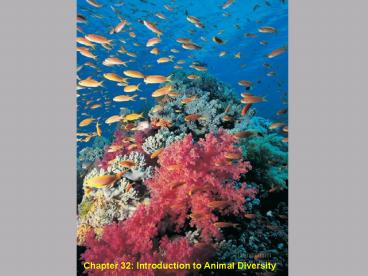Chapter 32: Introduction to Animal Diversity PowerPoint PPT Presentation
Title: Chapter 32: Introduction to Animal Diversity
1
Chapter 32 Introduction to Animal Diversity
2
Some major episodes in the history of
lifeCompare with Table 26.1
3
26.2 Clock analogy for some key events in
evolutionary history
4
26.16 Our changing view of biological diversity
5
32.10 One hypothesis of animal phylogeny based on
morphological and developmental comparisons
6
Kingdom Animalia general characteristics (and
yes, there are exceptions)
- Multicellular, heterotrophic eukaryotes
- Feed by ingestion
- Lack cell walls. Bodies held together by
structural proteins embedded in tissues
(collagen) and between cells (cadherins) - Presence of nervous and muscle tissue
- Store carbohydrate reserves as glycogen
- Reproduce sexually with characteristic
development of the early embryo - Transformation and development of the zygote
controlled by special regulatory genes (Hox
genes).
7
32.2 Early embryonic development in animals
8
32.2 Early embryonic development in animals
9
32.2 Early embryonic development in animals
10
47.8 Cleavage in a frog embryo
11
47.6 Cleavage in an echinoderm (sea urchin)
embryo
12
Sea urchin development, from single cell to larva
13
26.17The Cambrian radiation of animals.The
bars show the earliest appearance of several
animal phyla in the fossil record.
14
32.6 A sample of some of the animals that may
have evolved during the Cambrian explosion
15
Burgess Shale fossils
16
32.3 A zooflagellate colonyA colonial
flagellated protists not more than 2mm tall)
32.4 One hypothesis for the origin of animals
from a flagellated protists
17
A traditional view of animal diversity based on
body-plan grades
18
32.7 Body symmetry
19
(No Transcript)
20
Bilateria Bilateral symmetry
21
32.2 Early embryonic development in animals
22
47.11 Gastrulation in a sea urchin embryo
23
(No Transcript)
24
32.8 Body plans of triploblastic bilateria
25
32.9A comparison of early development in
protostomes and deuterostomes
PowerShow.com is a leading presentation sharing website. It has millions of presentations already uploaded and available with 1,000s more being uploaded by its users every day. Whatever your area of interest, here you’ll be able to find and view presentations you’ll love and possibly download. And, best of all, it is completely free and easy to use.
You might even have a presentation you’d like to share with others. If so, just upload it to PowerShow.com. We’ll convert it to an HTML5 slideshow that includes all the media types you’ve already added: audio, video, music, pictures, animations and transition effects. Then you can share it with your target audience as well as PowerShow.com’s millions of monthly visitors. And, again, it’s all free.
About the Developers
PowerShow.com is brought to you by CrystalGraphics, the award-winning developer and market-leading publisher of rich-media enhancement products for presentations. Our product offerings include millions of PowerPoint templates, diagrams, animated 3D characters and more.

